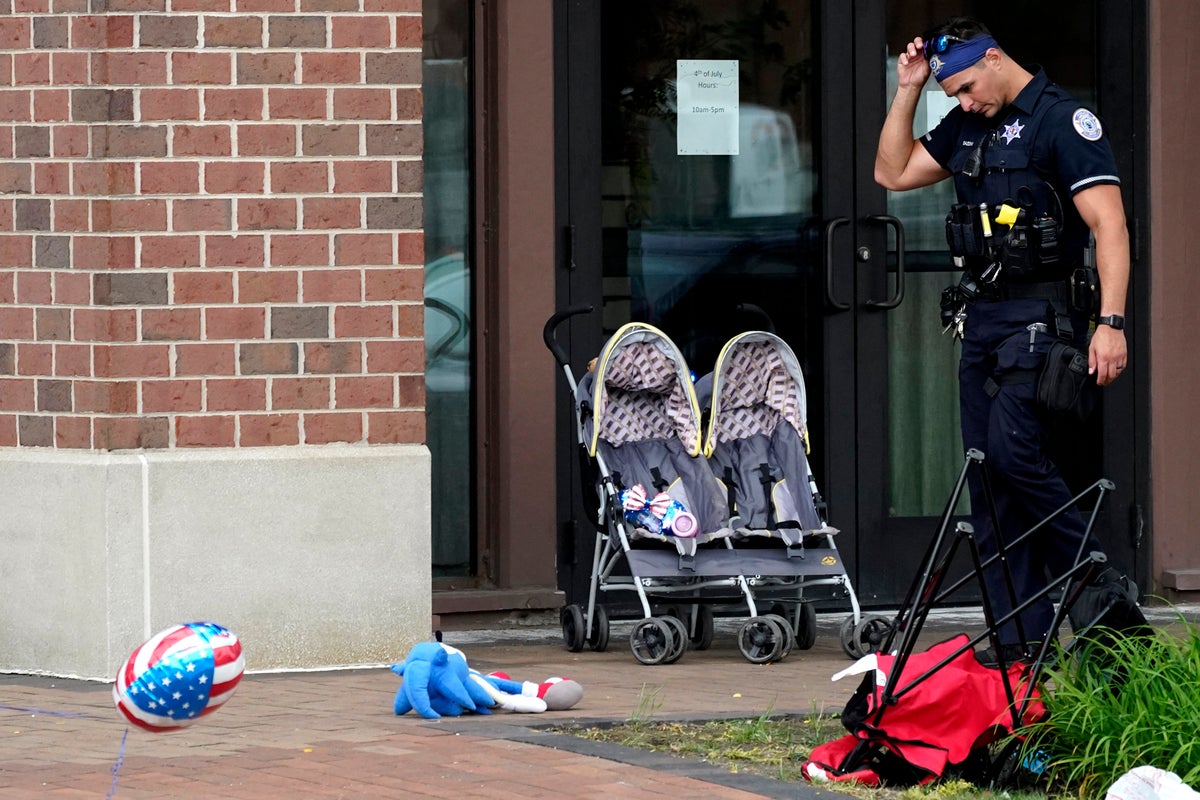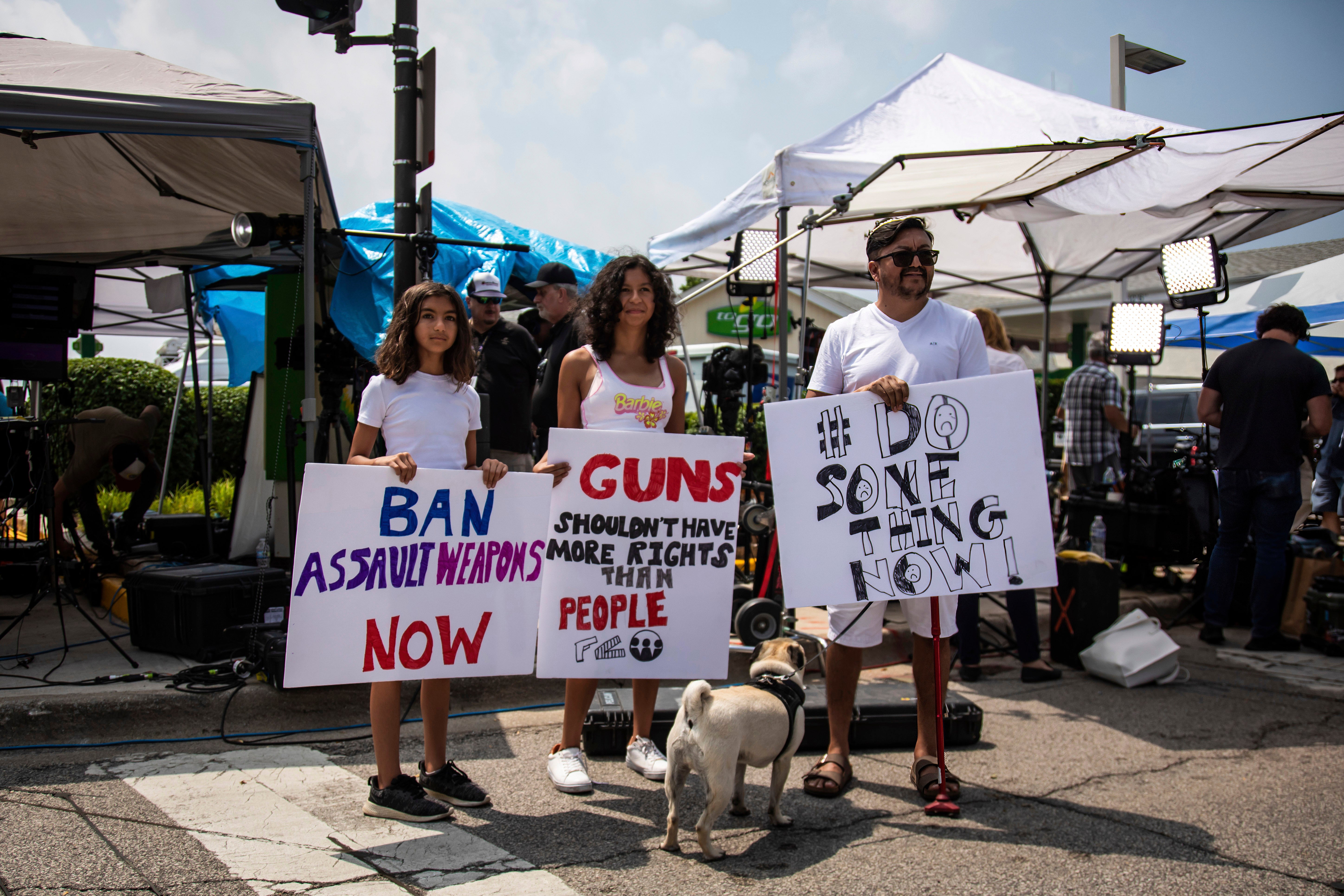
A suspected gunman climbed a fire escape, positioned himself on a roof above a Fourth of July parade and fired more than 70 rounds from a high-powered rifle.
In April 2019, police in Highland Park, Illinois, interacted with Robert Crimo following a suicide attempt. Mental health professionals intervened.
Later that year, a family member reported that he was threatening to “kill everyone” in their household, and police removed 16 knives, a dagger and a sword from the home. He was not arrested.
Over the next two years, he purchased five firearms – including at least two AR-style rifles, pistols and a shotgun. The weapon that was used to kill at least seven people and injure dozens of others was purchased legally. It fired “high-velocity rounds similar to an AR-15,” according to Chris Covelli, spokesman for the Lake County Major Crime Task Force.
Mr Crimo’s digital footprint – including music videos on YouTube with thousands of views – spans deeply nihilistic, disaffected online communities, incubating conspiracy theories and rejecting reality, with an accelerationist outlook towards mass death and violence. None of these were flags to law enforcement.
Highland Park – in a case that reached the US Supreme Court – has outlawed the kinds of weapons used in the massacre, in a state with restrictive gun laws, none of which stopped violence on Independence Day. A fragile patchwork of federal, state and local laws to combat the proliferation of guns – which vastly outnumber Americans – may have helped curb the severity of some mass shootings, but gun violence prevails with frightening regularity as long as they are available.
Mr Crimo has had a valid Firearm Owners Identification card – which is required to legally possess or purchase firearms or ammunition in Illinois – since 2020, when he was roughly 18 or 19 years old.
But Illinois State Police were notified about the 2019 incident, raising questions about how he came to legally possess a firearm.
He did not have a pending application for the FOID card at the time of the incident, so law enforcement had “nothing to review”, according to Illinois State Police Master Sgt Delilah Garcia.
He faces seven counts of first-degree murder and life in prison if convicted.
Years earlier, city officials voted to ban assault weapons entirely under a 2013 ordinance that prohibits the manufacture, sale or possession of semi-automatic guns with large magazine capacities. Unlike Highland Park, Illinois state law does not prohibit assault weapons.
Highland Park residents who had legally owned such weapons before the law took effect had 90 days to surrender them or render them inoperable as an assault weapon.
The ordinance, signed by Mayor Nancy Rotering on 24 June, 2013, asserts that “assault weapons are traditionally not used for self-defense in the city of Highland Park, and that such weapons pose an undue risk to public safety.”
“We do not need Sandy Hook in Highland Park,” resident Tom VandenBerk told the City Council at the time, referring to the 2012 massacre at an elementary school in Newtown, Connecticut, the Chicago Tribune reported.

The Illinois Rifle Association later filed a lawsuit against the city to revoke the assault weapons ban, arguing that it violates the Second Amendment.
A federal appeals court sided with the city, ruling that municipalities’ regulation of firearms does not strike against a constitutional right to bear arms and instead creates a “substantial benefit” if it “reduces the perceived risk from a mass shooting, and makes the public feel safer as a result”.
“Assault weapons with large‐capacity magazines can fire more shots, faster, and thus can be more dangerous in aggregate. Why else are they the weapons of choice in mass shootings?” the judges wrote. “A ban on assault weapons and large‐capacity magazines might not prevent shootings in Highland Park (where they are already rare), but it may reduce the carnage if a mass shooting occurs.”
The US Supreme Court declined to intervene, keeping the law intact.
In his dissent, Justice Clarence Thomas argued that “the overwhelming majority of citizens who own and use such rifles do so for lawful purposes, including self-defense and target shooting. … Under our precedents, that is all that is needed for citizens to have a right under the Second Amendment to keep such weapons.”
Nearly one decade later, Justice Thomas – writing the new court’s conservative majority opinion striking down a New York law that mandates that gun owners who wanted a permit to carry a concealed weapon in public must show proper cause – said that “we know of no other constitutional right that an individual may exercise only after demonstrating to government officers some special need”.
“It is not how the Second Amendment works when it comes to public carry for self-defense,” he said in the court’s opinion on 23 June 2022.
Illinois, like New York, has similarly restrictive gun laws. Those who wish to obtain a firearm must pass a background check and get a license from law enforcement – which can revoke licenses for people convicted of domestic battery and other crimes.
The state also has a so-called “red flag” warning system – which law enforcement has recognised should have been used to seize weapons from Crimo if he made threats against his family.
Police in New York also did not invoke the state’s red flag law for Payton Gendron, who was charged in the mass killing of 10 people in a grocery store in Buffalo in May. He received a mental health evaluation after suggesting a threat to kill others and himself at his school roughly one year earlier.
Nineteen states and Washington DC have red flag laws. Between 1999 and 2021, at least 16,857 petitions were filed to deny people at extreme risk from obtaining a firearm, according to Everytown for Gun Safety.
A 2019 study found that as many as 21 mass shootings might have been prevented in California after the state implemented its red flag law in 2016.
The Giffords Law Center ranks Illinois as having the eighth-strongest gun laws among US states. Everytown for Gun Safety, another gun control advocacy group, ranks the state as having the sixth-strictest gun safety laws, as well as the ninth-lowest rate of gun ownership.
Despite its relatively high marks for gun control, half of the firearms recovered in Illinois came from out of state, according to an analysis from The Washington Post.One out of six guns came from neighbouring Indiana, which Giffords ranks as having the 26th weakest gun laws in the US.
Only 14 states require universal background checks for all sales, whether guns are purchased from a licensed dealer or an unlicensed seller, according to Giffords.
That patchwork nature of gun control laws and efforts to curb the proliferation of high-powered weapons also follows the expiration of a federal assault weapons ban in 2004.
The national ban on firearms with large capacity magazines lasted from 1994 to 2004 as part of the Violent Crime Control and Law Enforcement Act.
Congress failed to renew the ban after the law’s “sunset provision” let it lapse. But that 10-year span gave gun violence researchers a clear beginning and endpoint to study whether an outright ban on high-powered rifles had a measurable impact.
One study from Northwestern University estimates that the ban prevented 10 mass shootings during the decade it was in place and would have prevented 30 mass shootings that killed 339 people and injured an additional 1,139 people if it remained in place after 2004.
Another study, published by the Journal of Trauma and Acute Care Surgery in 2019, determined that mass shooting deaths were 70 per cent less likely within the ban period.
The Washington Post’s analysis of 41- gun-related mass killings in the US since 2015 found that roughly one-third could have been prevented with a major policy proposal.
Last month, President Joe Biden signed a bill into law that provides support for enhanced background checks for people under 21 years old and closes the so-called “boyfriend loophole” to block dating partners from obtaining firearms under laws that prohibit domestic violence offenders from doing so.
The legislation did not revive the federal assault weapons ban, despite the president’s repeat demands that Congress extend it.
“We have to get rid of assault weapons, high-capacity magazines” and enact many other “common-sense reforms that wide majorities of Americans are crying out for,” she said.
The tragedy in Highland Park is the 15th mass killing of 2022 and the 11th mass shooting of the holiday weekend, according to the Gun Violence Archive. Halfway through the year, there have been at least 309 mass shootings.
Following the mass shooting, Illinois Lt Governor Juliana Stratton called for additional gun restrictions, saying that “there are too many guns on our streets and we must enact common sense gun laws, stricter policies, and put resources in place to build the safe, healthy communities everyone deserves.”
“Our founding fathers carried muskets, not assault weapons,” Illinois Governor JB Pritzker said during a press conference on 4 July. “And I don’t think a single one of them would have said, ‘You have a constitutional right to an assault weapon with a high-capacity magazine.’ … We as a nation deserve better.”







